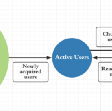Developing Big Ideas: 10 Things We Learnt
“How do we get to be more ambitious?”
“My team are good, they’re busy, they’re doing good stuff. But it’s all optimisation. How do we make big leaps?”
“How do we help them really have an impact on customers and the business?”
We hear these questions from the people and businesses we work with all the time. Magnetic has worked shoulder-to-shoulder to help transform organisations and build in-house capabilities, equipping and empowering people with the skills and knowledge to create sustained impact.
Innovating in businesses isn’t easy. We’ve all seen businesses try and fail — ending in piles of post-it notes, wasted meeting time and ideas that don’t take off. It’s all about having effective and repeatable ideation and innovation process.
Recently, we helped a media company design and implement a rapid early ideation and discovery process. This process can be replicated, scaled, and embedded by any business — here’s how we did it.
The approach
The brief: Develop a rapid and repeatable process to come up with bigger and bolder ideas for the product pipeline.
Before you get started: Understand the current tools, techniques, processes and challenges, and identify the knowledge gaps.
For this project: We designed a repeatable 2-week “sprint” process that consists of 10 x days. Each day is a 1-hourly long workshop. Each activity or task was created and engineered to drive a specific outcome. The tasks were then combined and time-boxed into a 60-minute workshop.
Side note: The term “sprint”, originating from software development, is a set period of time during which specific tasks must be completed. At Magnetic, we tend to run projects in sprints to keep focus and time-box activities.
Diagram 1: High-level Rapid Innovation Sprint Project Plan
The Virtual Sprint
Everyone has busy schedules, not everyone is in the office at the same time and to make it work around the people we worked with, the sprint was run entirely remotely. We use miro — an online, virtual whiteboard collaboration tool. This allowed us to all connect, collaborate and run the workshop remotely.
For virtual workshops to work you need:
- Everyone to be on time and present during the workshop.
- Time set aside for activities outside of the workshop — and make sure this is flagged on the project plan ahead of starting.
- The right technology for collaborations — we use miro (there are other collaboration tools available).
- Think about what activities need more time and can be set as work outside of the workshop — things like research, prototyping and pitch prep.
- 6–8 participants is an ideal number. Less than 6 it’s harder to create meaningful discussion.
- Bring in subject matter experts for specific activities with a specific action/outcome.
Throughout this entire process, we have come to learn 10 things that we believe will help any company to develop an ideation sprint.
The 10 things we learnt
- Mindset change is hard. It’s important to be empathetic and to help participants think differently. During the workshops constantly ask ‘if it’s technically do-able and resources are no object, what would you do?” This nudges people to think wider than what we do now and opens up the potential to have big, bold ideas.
- Get comfy with participants feeling uncomfy. The intensity and speed of a sprint can be uncomfortable for some. On-the-spot thinking and quick decision-making are not the norms in many businesses. Some even turn defensive. Instead try: setting up a separate session with specific participants (and team leads) and coaching them through the mindset required for a sprint, and the thinking behind each activity. This helps recruit influencers that can support participants in the room.
- Always align with company strategic goals. The outcome of the process and ideas need to be tied to the business strategic pillars or company strategy. Otherwise, what is the point?
- Preparation is king. Allow plenty of time for sprint design, setup, and planning In this case, it took a team of 3, a week to design a 10-day ideation sprint — the research and design of the sprint exercises and setting up the miro online board. Once the sprint framework is set up, the exercises can be reviewed, refreshed, and replicated in less than a couple of hours for the next sprint.
- The “feeling” of not having enough time. The #1 feedback — “there is not enough time to think through…” This is especially the case when reviewing ideas and developing prototypes. Our response: it’s been done before and the time is set on purpose. A focused amount of time creates a sense of momentum, expedites decision-making and doesn’t allow over-thinking.
- Rituals and time management are critical. Plan out the sprint sessions well in advance and highlight days where participants would require extra time for pre-work (homework), teamwork and research. Also, be aware of how tricky context switching can be. Consider everyone having to join the call 1 min early and being ready to go by 1 minute past.
- Think visually. Many people find it easier to learn through visuals. Encourage everyone to sketch ideas and watch with joy as the board fills up with mobile pictures of pencil sketches, crudely photoshopped mockups, emoji-covered miro mockups, and hundreds of screen grabs from other services.
- Wider stakeholder participation needed. During the process some ideas need wider stakeholder input, for example, the product team might require a legal or commercial point of view on a specific idea. Try to anticipate that need upfront when reviewing the brief with the team lead before starting the sprint. That way you can bring in the right subject matter experts at the right time.
- Show me the money! Don’t forget business viability. During the ideation phase or when the team has decided on a key idea, it’s important not to immediately go into technical feasibility mode — evaluating constraints and resource requirements. Instead, start with the potential of monetary return on investment and the value creation that will excite senior stakeholders. Business viability is something that we always actively encourage participants to think about during the sprint.
- Standardisation saves time and focuses actions. In the ideation sprint, we have canvases/ templates, e.g. briefing templates for design and prototyping, experiment canvas to record results, pitch presentation templates. We also assign a member of the testing team to guide the team in the experimentation process. The template and support provides frameworks for the team to focus on developing the solution to the problem rather than thinking about “how to” do it.
Now that you have a checklist of what to think about — get started. If you need a bit of help, we’re always happy to chat.
Magnetic is a design and innovation company that helps design better futures. We’ve worked with global businesses to build capabilities and transform organisations. If you’d like to find out more about our work, get in touch with Jen Jeng or drop us a line.
Author: Jen Jeng.





